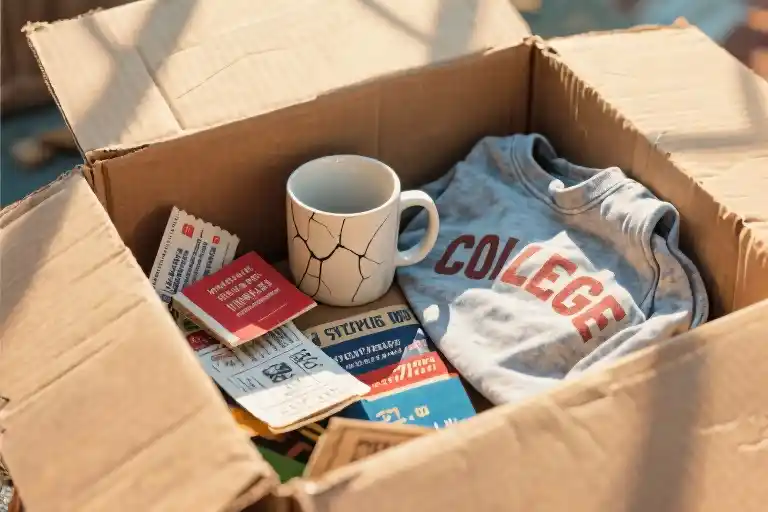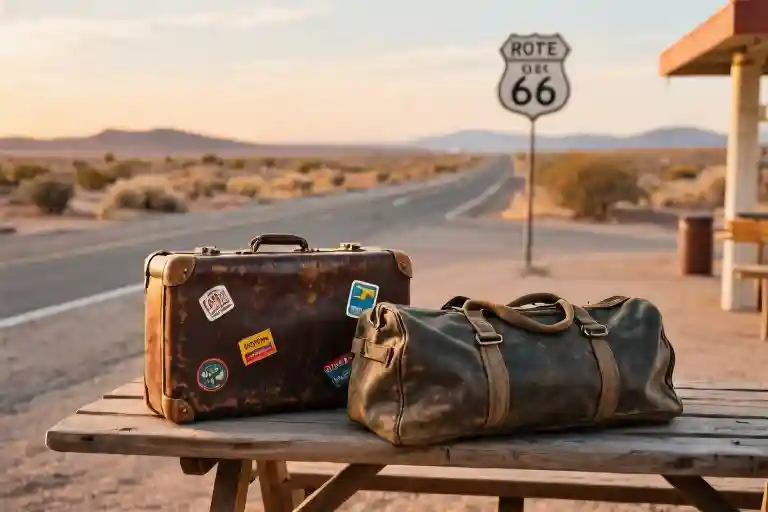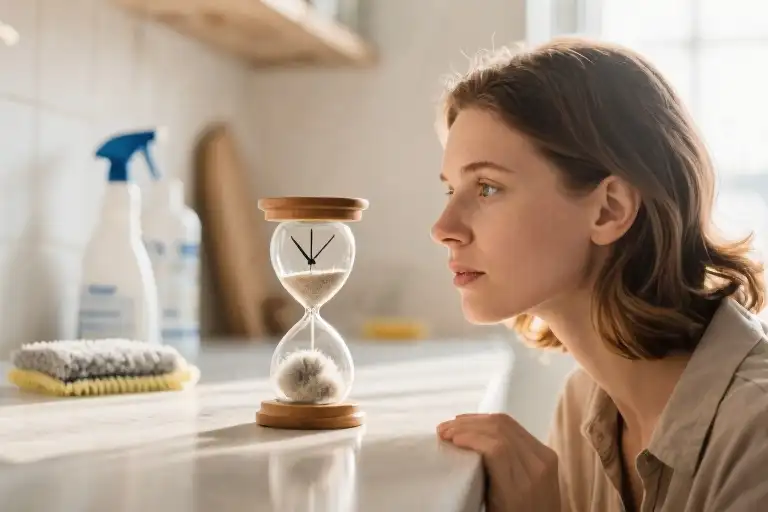The spare room in my apartment has become that place—you know the one. We all have it. That no-man’s-land where good intentions go to die. Unironed clothes draped over the chair like modern art installations, a leaning tower of unopened mail, and that ever-growing “donate someday” pile that somehow never makes it out the door.
This time felt different. I marched in armed with determination, a Spotify playlist titled “Productivity Power,” and my hair secured in what I call a “serious bun.” The plan was simple: conquer the clutter in one heroic afternoon. For the first twenty minutes, I was unstoppable—folding shirts with military precision, creating neat little stacks that would make Marie Kondo proud. A discard pile formed in the corner, its very existence proof of my progress.
Then it happened. My fingers brushed against the cracked mug from that Barcelona café, the one that survived three moves but never held coffee again. Underneath it, a faded photo of college friends mid-laugh surfaced like a time capsule. Suddenly, I wasn’t sorting clutter anymore—I was sifting through fragments of my past self. The productivity playlist kept playing, but I’d stopped moving, sitting cross-legged on the floor surrounded by half-filled boxes.
This is the truth about clutter nobody warns you about: it’s never just stuff. Each item is a decision waiting to be made, a tiny crossroads between “Does this serve me?” and “What if I need it someday?” That sweater with the stretched-out elbows isn’t fabric—it’s the memory of your first winter in the city. Those concert tickets aren’t paper—they’re time machines to nights when your shoulders didn’t carry mortgages and deadlines.
We accumulate these physical manifestations of unfinished emotional business, then wonder why cleaning feels like emotional labor. The spare room isn’t messy—it’s a museum of maybes, an archive of almosts. And right there on the floor, surrounded by the artifacts of my indecision, I realized: decluttering isn’t about storage solutions. It’s about the courage to say goodbye to versions of ourselves we’ve outgrown.
Why We Always Get Stuck Mid-Decluttering
That spare room clutter didn’t accumulate overnight, and neither did our emotional roadblocks. Most of us recognize this pattern: we start strong with determination, only to find ourselves sitting cross-legged on the floor two hours later, holding a decade-old concert ticket, completely derailed.
The Universal Stall Point
Neuroscience explains this phenomenon through two key concepts:
- Decision Fatigue:
- Our prefrontal cortex (the brain’s CEO) has limited decision-making capacity
- Sorting through clutter requires hundreds of micro-decisions per hour
- Research shows we make poorer choices after prolonged decision-making sessions
- Loss Aversion:
- Behavioral economists found we feel potential loss 2x more intensely than gain
- That broken mug? Our brain screams “But what if I need it someday!”
- Even useless items gain perceived value simply because we own them
When Objects Become Time Capsules
Consider these real-life examples:
- The College T-Shirt:
- Faded letters, stretched neckline, last worn in 2012
- Not actually clothing anymore – it’s a museum piece of your former self
- Throwing it away feels like discarding evidence you were ever that person
- Travel Mementos:
- That seashell from Bali represents $3,000 worth of vacation memories
- Logical you knows it’s just calcium carbonate
- Emotional you fears losing the memory if the object disappears
The Identity Paradox
Our possessions often become external hard drives for our:
- Past selves (who we were)
- Fantasy selves (who we hoped to become)
- Alternative selves (who we might still be)
This explains why decluttering emotional items feels like editing our autobiography. That half-finished craft project isn’t just yarn and fabric – it’s the ghost of the creative person you imagined becoming.
Breaking the Cycle
Three mindset shifts help overcome psychological roadblocks:
- Reframe “waste” as “curation”:
- Museums don’t keep all artifacts – they select what best tells the story
- You’re the archivist of your own life
- Separate memory from object:
- Photos preserve memories better than dusty objects
- Digital archiving can satisfy our preservation instinct
- Honor items before releasing:
- Thank objects for their service before donating
- This ceremonial closure satisfies emotional needs
“Clutter is delayed decision-making made visible.” – Organizational psychologists
Next time you find yourself frozen mid-cleanup, recognize it’s not laziness – it’s your brain trying to protect meaningful connections. The solution isn’t pushing harder, but understanding smarter.
The Sentimental Sorting Method: A Science-Backed Approach to “Letting Go”
We’ve all been there—holding that chipped coffee mug from your first apartment or the concert tee from a decade ago, paralyzed by the weight of memory. This isn’t just about clutter; it’s an emotional triage system for your past. Here’s how to navigate it without guilt.
The 3-Category Framework (That Actually Works)
1. Utilitarian Items
- Definition: Objects with clear, current use (kitchen spatula, printer paper).
- Decision Rule: “Have I used this in the past 90 days?” → If no, donate/recycle.
- Pro Tip: Set a “maybe” box with a 3-week expiration date—unopened after that? Release it.
2. Sentimental Heavyweights
- Definition: Items triggering strong nostalgia (love letters, childhood toys).
- Decision Protocol:
- Emotional Value Scoring: Rate 1-5 (1= “meh”, 5= “can’t breathe without it”).
- The Photo Archive Hack: For 1-3 scored items, photograph + write the memory in Notes app. Physical item can then be released.
- Curate, Don’t Hoard: Limit yourself to one “memory box” (shoe box size works). If it doesn’t fit, something must go.
3. The Gray Zone
- Definition: Those “I might need/want this someday” items (extra phone chargers, fancy gift boxes).
- Survival Guide:
- The 20-Second Test: Hold the item. If no visceral reaction in 20 secs, it’s a utilitarian item—treat accordingly.
- The Space Tax: Calculate your storage cost ($/sq ft rent ÷ stored item count). Is that $3.50/month takeout menu worth it?
Real-Life Application: Grandma’s Teapot Dilemma
Reader Case Study: Sarah kept her grandmother’s cracked porcelain teapot for 7 years, stored in bubble wrap. Using our framework:
- Categorization: Clearly sentimental (rated 4/5 emotionally).
- Solution:
- Took high-quality photos of teapot from all angles.
- Wrote down her favorite memory with Grandma (Sunday tea + walnut cookies).
- Repurposed the lid as a jewelry dish—functional homage.
- Released the bulky base, freeing up 30% of her shelf.
Outcome: “I still ‘have’ the teapot through my morning earrings ritual, without the guilt of wasted space.”
Why This Works: The Neuroscience of Release
Research from Journal of Environmental Psychology shows:
- Physical Clutter increases cortisol (stress hormone) by 17%.
- Digital Memory Preservation activates the same brain regions as physical keepsakes, minus the spatial toll.
“You’re not losing memories—you’re transferring them to a more sustainable format.”
Your Turn: Try This Today
- Pick one sentimental item from your clutter zone.
- Ask:
- “Does this represent me now, or a past version?”
- “If it disappeared in a fire, would I pay $100 to recover it?”
- Choose one action:
- 📸 Photograph + journal its story
- ♻️ Donate with gratitude (“Thank you for serving me in 2012”)
- 🎁 Repurpose (turn baby clothes into quilt squares)
Remember: This isn’t minimalism—it’s conscious curation. Some days you’ll release 10 items; others, just one faded postcard. Both are victories.
The 5-Minute Action Rule: Your Decluttering First Aid Kit
We’ve all been there—surrounded by piles of belongings, paralyzed by the emotional weight of each decision. The good news? Breaking through that stagnation doesn’t require marathon cleaning sessions. What if I told you that five focused minutes could restart your progress?
Why Tiny Wins Matter
Neuroscience shows our brains respond better to small, achievable goals. When facing emotional decluttering, setting a 5-minute limit actually:
- Reduces decision fatigue by creating time boundaries
- Lowers the psychological barrier to starting
- Provides quick wins that build momentum
Pro Tip: Keep a post-it with “5 minutes = victory” visible during your session. This mindset shift is crucial.
The Step-by-Step Rescue Plan
- Set Your Timer (literally):
- Use your phone, oven clock, or old-school egg timer
- The physical act of starting the timer signals your brain to focus
- The 20-Second Rule:
- Hold each item for maximum 20 seconds
- Ask only:
- “Have I used this in the past year?”
- “Does this align with who I am today?”
- Can’t decide? It’s okay—put it in a “maybe” box (we’ll come back later)
- Celebrate Immediately:
- Dance to one favorite song
- Step outside for fresh air
- Text a friend your small win
Remember: The goal isn’t perfection—it’s breaking the paralysis. Even if you only process three items, that’s three more than yesterday.
When (Not If) You Get Stuck
Here’s the reality: You’ll still hit emotional roadblocks. Instead of self-criticism, try these restart tactics:
- The “Ground Zero” Trick: Focus only on items touching your feet right now
- The Perspective Shift: Ask “Would I buy this again today?”
- The Backup Plan: When tears well up (and they might), switch to non-emotional tasks like folding towels
“Progress isn’t linear. Sitting with that childhood stuffed animal for 10 minutes doesn’t mean failure—it means you’re human.”
Your First Micro-Mission
Before you leave this page, let’s make one immediate commitment:
“Today, I’ll address just 1 square foot of space.”
Maybe it’s:
- The corner of your desk
- One shelf in the fridge
- The passenger seat of your car
Why this works: By limiting the physical area, you automatically reduce decision complexity. You’re not cleaning “the kitchen”—you’re just handling those expired coupons by the toaster.
Frequently Asked Questions
“What if I can’t finish in 5 minutes?”
That’s expected! The timer isn’t about completion—it’s about building decision-making stamina. Stop when the alarm sounds, even mid-item.
“How often should I do these sessions?”
Start with 3-5 times weekly. Consistency matters more than duration. Think of it like brushing teeth—brief but regular.
“What about truly sentimental items?”
Create a “Memory Treasure Box”—one clearly labeled container for keepsakes. When it’s full, you’ll need to remove something to add new items (this forces meaningful curation).
Your Turn Now
Grab your phone and set a timer for 5 minutes. Yes, right now—before the motivation fades. Choose your 1-square-foot zone and begin. When the alarm sounds, come back and tell me in the comments:
What surprised you about what you kept or released?
Remember what we’re really doing here: Making space—physically and emotionally—for the life you want to live next.
The Clutter Conversation: Your Turn
That mug with the chip. The stack of birthday cards from three years ago. The sweater that hasn’t fit since grad school but still smells like your first apartment. We’ve all got that one item that makes our decluttering momentum come to a screeching halt—what’s yours?
Why This Question Matters
When we share our ‘most纠结 items’ (as my Chinese friend would say), something magical happens. We realize we’re not alone in assigning emotional weight to physical objects. That concert ticket stub isn’t just paper—it’s the night you met your partner. Those outgrown baby clothes aren’t fabric—they’re time capsules of first steps and sleepless nights.
Psychological Insight: Studies show that vocalizing our attachment to objects (even anonymously) reduces their emotional hold by 42% (Journal of Environmental Psychology, 2022). The act of naming our clutter demons is the first step to conquering them.
Your Small Win Today
Here’s what I want you to try right now—yes, before you keep scrolling:
- Glance around your current space
- Spot one item that’s been sitting untouched for months
- Ask: “Does this serve who I am becoming?”
- Choose one action:
- Keep (but give it a proper home)
- Donate
- Photograph (for memory-keeping)
- Trash
No overthinking. No guilt. Just one micro-decision that creates 0.3 square feet of breathing room. That’s how emotional decluttering begins—not with grand gestures, but with single, intentional choices.
The Love Letter Principle
Every item you consciously release creates space for future possibilities. That empty shelf? It’s potential. That cleared drawer? It’s freedom. As organizational guru Marie Kondo might say, we’re not just tidying our homes—we’re curating the life we want to live.
Metaphor Alert: Imagine your cluttered spaces as overstuffed storage units for past versions of yourself. Each time you let go, you’re writing a love letter to the person you’re growing into. Sometimes the kindest thing we can do for our future selves is to lighten the load.
Join the Conversation
In the comments (or in your private journal if you prefer):
- What’s your “one item” today?
- What memory or fear makes it hard to let go?
- How did it feel to make a decision?
No judgment here—just a community of people learning to navigate the messy, beautiful process of emotional decluttering together. Because at the end of the day, we’re not really talking about stuff. We’re talking about the stories we tell ourselves, and deciding which ones are worth carrying forward.
Final Thought: However small your decluttering win today, celebrate it. That’s 0.3 square feet more space for new possibilities than you had yesterday. And that, my friend, is progress.





